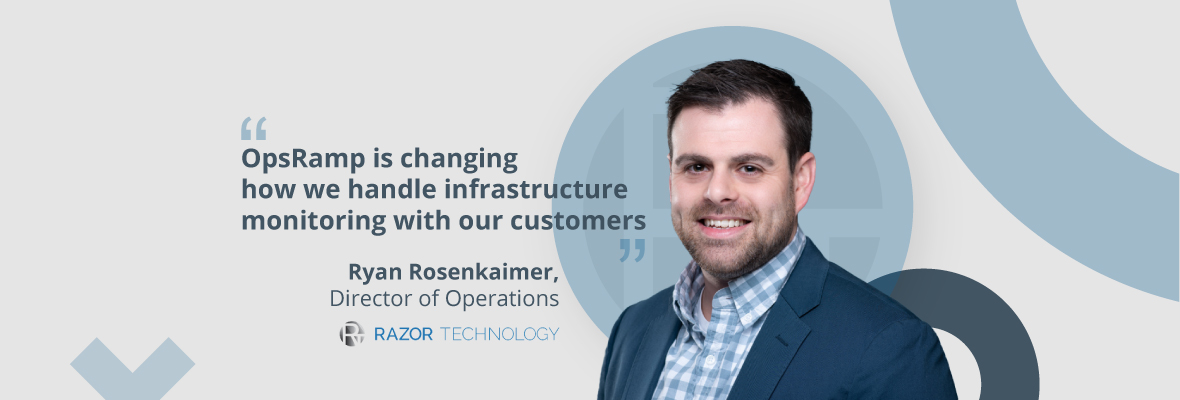Ryan Rosenkaimer is Director of Operations at Razor Technology, a managed services provider (MSP) customer and partner of OpsRamp. Founded in 2004 and based in Philadelphia, Razor serves more than 300 clients in the greater Northeast and Mid-Atlantic regions. The company is using OpsRamp to deliver managed cloud services to its clients and also resells OpsRamp as a service.
OpsRamp: Tell us about your business and what kind of challenges your customers are facing right now?
RR: We work with financial services, healthcare and pharmaceutical, media and other verticals and with small to medium up to large enterprises like Crayola, Weis Markets, and Lehigh Valley Hospital. Our customers have very diverse IT environments and maturity levels. While some customers use us just for cloud services, disaster recovery and infrastructure projects; others are using us for full managed services including help desk. Many of our customers had to make quick decisions and adopt new cloud technologies this year to stay in business. Fortunately, we had already helped establish hybrid IT infrastructures for many of them, so they could use that infrastructure to rapidly allow employees to connect back into the corporate network securely.
OpsRamp: How have needs evolved for customers since the onset of Covid- 19?
RR: In the beginning, customers needed help with secure remote access to daily apps whether they lived on premise or in the cloud. We were busy spinning up more resources for customers and adding collaboration tools like Microsoft Teams and Office 365, configuring VPN tunnels, remote desktop gateways, Citrix and VDI. Months later, customers are now working with us to strategically begin spending more money in IT, and planning how to enable long-term remote work and business expansion.
OpsRamp: Are you seeing more investment in the public cloud?
RR: Absolutely, and we’re seeing them turn to a partner like us to properly plan this out. Razor can help customers in many ways, from developing applications for the cloud, migrating applications, or spinning up new resources in the public cloud. We are definitely seeing growth in the multi-cloud and hybrid cloud universe now. Customers are choosing different clouds based on functionality, workloads and what makes sense economically. In some cases, co-location is cheaper because of the flat rate. One barrier to the public cloud is that there is still ample confusion about spend. People can look at the tools which the cloud providers offer, but they still don’t include everything. Extra costs appear on the bill, and it’s hard to determine why.
We recommend customers expand into the cloud gradually in phases so that they can compare outcomes and cost-effectiveness of using different public cloud providers."
OpsRamp: How are you helping customers overcome the hurdles of managing these different environments?
RR: In today’s world you get the flexibility of migrating your applications and systems to all these different places; however, you will lose control without the ability to monitor all the elements and correlate how they work together. OpsRamp ITOM is a really effective platform to visualize those trends so we can advise customers on how to safely distribute workloads to different environments.
OpsRamp: How is Razor using the OpsRamp platform?
RR: OpsRamp is changing how we handle infrastructure monitoring with our customers and getting them to recognize the benefit of a single pane of glass viewpoint. This provides an understanding of how different devices and resources interact with each other. You can see how, for instance, the degradation of your storage will directly affect the public facing customer application and then fix it before it becomes an issue. We can also use the data we ingest from tracking systems and resources in OpsRamp to paint a different picture. We are looking at new ways to correlate the data we pull daily to provide new recommendations for lifecycle management, where to use automation and how to save time and money. We can also share examples from other customers regarding similar issues they are experiencing and how to resolve them. We are about to pass 20 customer environments and more than 3,000 devices managed in OpsRamp.
OpsRamp: How are you offering OpsRamp to your customers?
RR: Our customers get access to the platform as part of one of our packaged managed services in which we do the set up and implementation and roll out the best practices to make it really simple and quick for them to begin getting value. We are doing the due diligence for customers by selecting a high-profile tool that’s proven in the market.
OpsRamp: Why is the status quo so hard to break in enterprise IT when it comes to change and modernization?
RR: For us, the greatest hurdle is developing trust with the people that we want to work with in IT and demonstrating that we are not a threat but an ally who can help build solutions into their business. There is still a common perception that MSPs are just there to replace your team. Our job is to convince them that we are not coming in to sub out costs, but to address larger pain points and objectives, allowing IT employees to focus on their strengths and augment our teams to help with the overflow.
Next Steps
- Learn more about the OpsRamp Partner program
- The Future of Managed Service Providers
- 10 Reasons Why MSPs Choose OpsRamp





